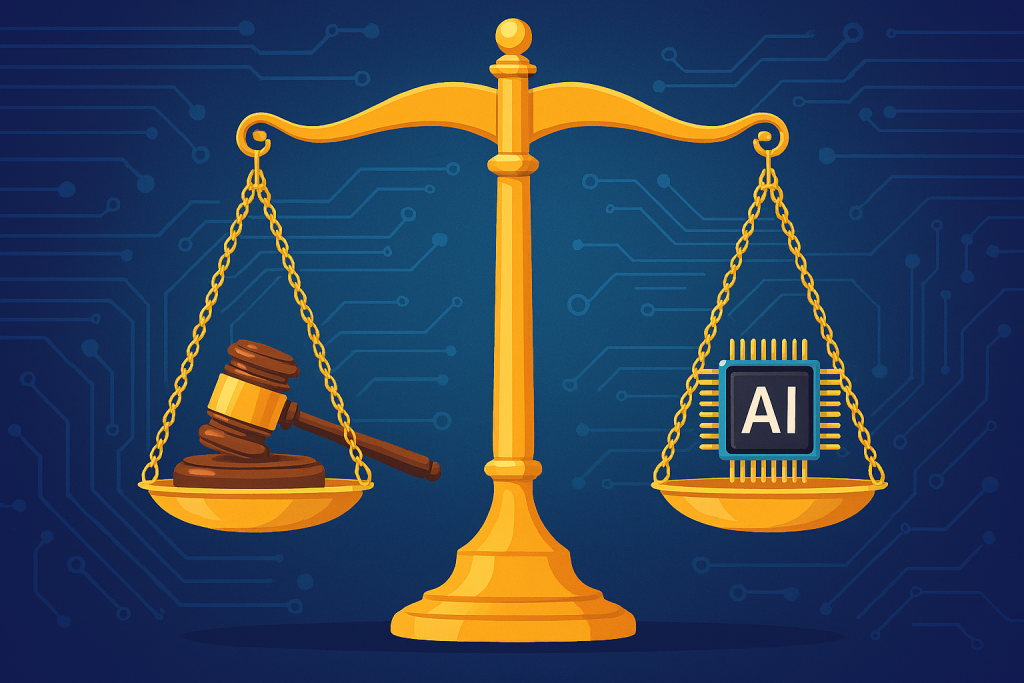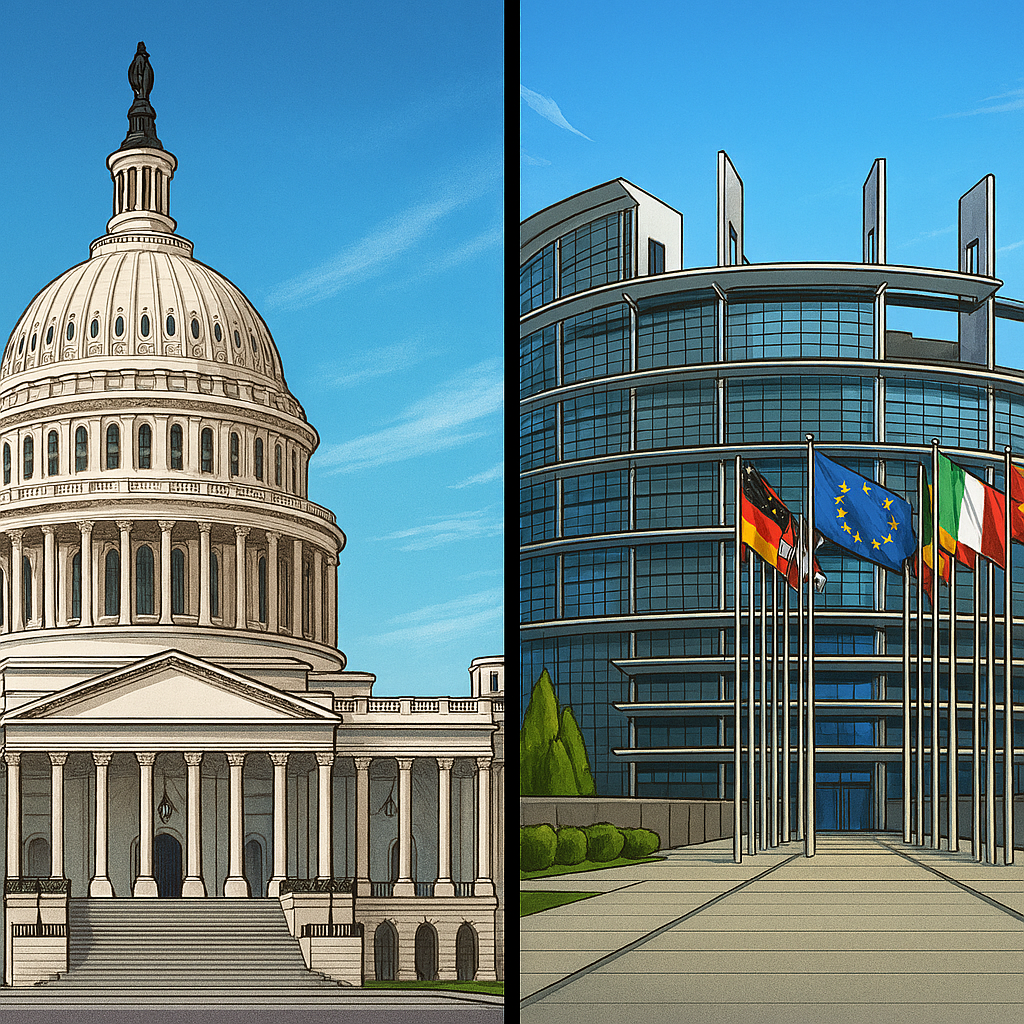The leaked draft order from the White House signals a dramatic escalation in America’s struggle over AI power governance. By directing the Department of Justice to sue states that pass their own AI regulations, the administration is attempting to consolidate control over a technology that is reshaping economies, geopolitics, and daily life. This move raises fundamental questions: Who sets the rules for AI? What risks do we face if regulation is centralized—or fragmented? How will these decisions ripple down to ordinary citizens?
Artificial intelligence is no longer a futuristic concept—it’s here, shaping hiring decisions, credit scores, and even the way governments deliver services. So who should decide the rules for this powerful technology? Washington, or the states? That’s the question now at the center of a brewing legal and political storm.

🏛️ Federal Authority vs. State Sovereignty
The Federal Gambit
The Trump administration, in an AI power grab, is reportedly preparing an executive order that would direct the Department of Justice to sue states that pass their own AI regulations. The rationale? A patchwork of state laws could slow innovation and weaken America’s ability to compete globally. As President Trump put it bluntly: “We MUST have one Federal Standard instead of a patchwork of 50 State Regulatory Regimes. If we don’t, then China will easily catch us in the AI race”.
It’s a compelling argument on the surface. After all, AI systems don’t stop at state borders. But is uniformity always better than diversity?
State Pushback
California and Colorado have already passed comprehensive AI laws aimed at transparency and bias mitigation. Lawmakers there argue that local protections are essential. California State Sen. Scott Wiener, who authored one of the state’s AI safety laws, dismissed the federal plan: “Trump has no power to issue a royal edict canceling state laws”.
And it’s not just Democrats. Florida Gov. Ron DeSantis warned that stripping states of authority would amount to a “subsidy to Big Tech” and prevent states from protecting against predatory applications and censorship.
So the question becomes: are state laws a safeguard against abuse, or a roadblock to progress?
- The federal gambit: The administration argues that AI is too vast, too international, and too economically critical to be governed by a patchwork of state laws. They cite interstate commerce and national competitiveness as justification for overriding state frameworks.
- State pushback: States like California and Colorado have already passed comprehensive AI laws targeting bias, transparency, and consumer protection. These laws reflect local concerns—employment discrimination, housing fairness, and privacy—that federal rules may dilute.
- Legal tension: Courts have historically limited presidential attempts to direct DOJ enforcement strategies. Immigration and data privacy battles show how federal overreach can be challenged under the Constitution’s balance of powers.

⚖️ Ethical Concerns and Governance Gaps
The Legal Tension
Can a president really tell the DOJ to sue states en masse? Legal experts are skeptical. Frank Pasquale, a professor at Cornell Law School, noted: “The order won’t do anything because it doesn’t change the law… Only Congress does”. Courts have historically limited presidential attempts to direct enforcement strategies, whether on immigration or data privacy. This fight could end up being less about AI power itself and more about constitutional boundaries.
- Transparency and accountability: UNESCO’s global AI ethics framework emphasizes human rights, proportionality, and accountability. Many state laws attempt to embody these principles, while federal proposals remain vague.
- Surveillance risks: Without strong guardrails, AI systems risk expanding government and corporate surveillance, eroding trust in both institutions.
- Bias and fairness: State-level rules requiring audits of hiring algorithms or credit scoring tools directly protect citizens from discriminatory outcomes. Federal preemption could weaken these safeguards.
Regulated vs. Unregulated Futures
| Path | Advantages | Risks |
|---|---|---|
| Federal preemption | Uniformity, clarity for industry, stronger national security posture | Overreach, weaker local protections, litigation delays, public distrust |
| State patchwork | Tailored protections, democratic proximity, policy experimentation | Compliance burden, uneven protections, forum shopping |
| Co-regulation | Federal baseline + state augmentation | Requires political compromise, but balances uniformity with local agility |
🌐 The AGI Race Narrative
The Industry Perspective
Tech leaders, unsurprisingly, lean toward federal preemption. OpenAI CEO Sam Altman told Congress earlier this year that “it is very difficult to imagine us figuring out how to comply with 50 different sets of regulation”. Nvidia’s Jensen Huang has praised federal efforts to streamline AI governance, arguing that innovation depends on clarity.
But others, like Brookings’ Nicole Turner Lee, caution that state laws are filling a vacuum left by Washington’s inaction: “If federal legislators could come up with a plan that protected both innovation and consumer protection, that would be a win‑win”
- Fear of falling behind: Advocates of federal dominance argue that restricting AI development domestically only cedes ground to rivals like China. If America doesn’t achieve artificial general intelligence (AGI) first, another nation might—and gain strategic advantage.
- Founded fears: Loss of control, catastrophic misuse, and concentration of power are real risks flagged by RAND and UN reports.
- Unfounded fears: The idea that “first mover wins all” is exaggerated. Governance capacity, safety protocols, and public trust matter as much as raw speed.
- Global coordination: UN experts recommend observatories, certification, and conventions to manage AGI risks. A unilateral U.S. race strategy could undermine international safety efforts.

🎭 Everyday Citizen Impact
Everyday Impacts
Why does this matter to ordinary citizens? Because AI is already making consequential decisions. State laws often guarantee notice and appeal rights when algorithms deny someone a job, a loan, or housing. If federal preemption wipes those out, citizens could be left with fewer protections and little recourse. As Sen. Elizabeth Warren warned, “If included, this provision would prevent states from responding to the urgent risks posed by rapidly deployed AI systems, putting our children, our workers, our grid, and our planet at risk”
- Jobs: AI will accelerate automation. States with stronger transparency rules may offer citizens clearer recourse against unfair hiring practices.
- Privacy: Federal preemption could weaken protections against surveillance and data misuse, leaving citizens more exposed.
- Fairness: State laws often guarantee notice and appeal rights in credit, housing, and benefits decisions—rights that may vanish under weaker federal standards.
- Trust: Americans already distrust both government and corporations to use AI responsibly. Diluting state protections could deepen skepticism and slow adoption.
The Bigger Picture
The debate isn’t just about regulation—it’s about trust. Americans already distrust both government and corporations to use AI responsibly. Diluting state protections could deepen skepticism. And while the administration frames this as a race against China, RAND and UN experts remind us that speed without safety is a false advantage. Governance capacity, not just raw innovation, determines who wins in the long run.

🌍 Two Visions of AI Governance: The U.S. vs. the EU
Artificial intelligence is not just a domestic issue—it’s a global one. And while Washington debates whether to strip states of their authority to regulate AI, Europe has already passed sweeping legislation. The contrast between the U.S. and the EU reveals two very different philosophies of governance, and the friction between them could shape the future of transatlantic tech policy.
The European Model
The EU’s AI Act, passed in 2024, is the world’s first comprehensive law governing artificial intelligence. It takes a risk‑based approach, classifying AI systems into categories—high‑risk, limited‑risk, and minimal‑risk—with corresponding obligations. High‑risk systems, such as those used in healthcare, law enforcement, or employment, face rigorous requirements including conformity assessments, documentation, and penalties tied to global turnover.
As one EU commissioner put it: “We want AI to be trustworthy, not just powerful. Citizens must know that when AI makes decisions about their lives, it does so fairly and transparently.”
The American Patchwork
By contrast, the U.S. has no unified federal AI law. Instead, it relies on executive orders, voluntary frameworks, and state‑level rules. The Biden administration’s Executive Order on AI emphasized innovation, competition, and civil rights, but stopped short of binding requirements. States like California and Colorado have stepped in with their own laws, mandating bias audits and transparency in automated decision‑making.
This fragmented approach reflects America’s political culture: decentralized, innovation‑first, and wary of heavy regulation. As OpenAI’s Sam Altman told Congress: “It is very difficult to imagine us figuring out how to comply with 50 different sets of regulation.”
Where They Clash
The EU’s model prioritizes citizen protection and ethical safeguards, while the U.S. prioritizes competitiveness and flexibility. That divergence creates friction in several areas:
- Compliance costs: Multinationals operating in both markets face strict EU penalties but lighter, inconsistent U.S. enforcement.
- Online platforms: The EU imposes transparency rules on recommender systems and social media algorithms; the U.S. has yet to legislate in this space.
- Global standards: The EU aims to set the benchmark for trustworthy AI, while the U.S. resists binding rules, preferring voluntary guidelines.
Brookings analyst Alex Engler warned: “Regarding many specific AI applications, especially those related to socioeconomic processes and online platforms, the EU and U.S. are on a path to significant misalignment”.
Why It Matters
For citizens, the difference is tangible. Europeans will soon have enforceable rights to challenge AI decisions in sensitive areas. Americans may depend on state laws—or none at all. For companies, the divergence means navigating two regulatory universes, one strict and centralized, the other fragmented and uncertain.
And geopolitically, the split risks weakening democratic alignment. If the U.S. and EU cannot harmonize their approaches, authoritarian competitors may exploit the gap.
The U.S. and EU basically share the same goal: harness AI’s power while protecting society. But they are pursuing it in very different ways. Europe’s AI Act is a bold experiment in centralized regulation. America’s patchwork reflects its federalist DNA. The challenge now is whether these two visions can be reconciled—or whether they will collide, leaving citizens and companies caught in the middle.

🥜 The Final Nut
So where do we go from here? The administration’s leaked plan is more than a legal maneuver—it’s a referendum on how America will govern the most powerful technology of our era. Centralization promises speed and competitiveness, but risks eroding trust and weakening protections. Decentralization offers tailored safeguards but complicates compliance. The real challenge is to craft a federal floor with state teeth: national baselines for transparency, provenance, and safety, paired with state authority to address local harms. Anything less risks leaving citizens caught between unaccountable algorithms and a government more concerned with global competition than everyday fairness.
The stakes are clear: if America gets this wrong, citizens could face a future where AI systems are powerful but unaccountable, fast but unsafe, and everywhere but trusted nowhere. The real question isn’t whether America wins the AI race. It’s whether Americans can trust the systems that increasingly govern their lives.
Any Questions or Concerns Contact Us here or comment below. Thank You for Your Time.
📚 Curated Source List
- Brookings Institution – AI Regulation Analysis Brookings on U.S. vs EU AI governance misalignment
- RAND Corporation – AGI Risks and Governance RAND report on artificial general intelligence risks
- UNESCO – Global AI Ethics Framework UNESCO Recommendation on the Ethics of Artificial Intelligence
- United Nations – AGI Coordination Proposals UN experts on global AI governance
- Legal Curated – U.S. vs EU AI Act Conflict Legal Curated summary of EU AI Act vs U.S. governance
- Cornell Law School – Frank Pasquale Commentary Cornell Law professor Frank Pasquale on limits of executive orders
- School of Government Luiss Guido Carli Eu & US regulatory approach to AI
- Politico White House Prepares E.O. to block state laws
- AOL Trump calls for federal AI standards
- Newsweek Donald Trump faces new MAGA discontent over AI proposal
- Inc.com Trump wants to bar sates from regulating AI again
- PBS Senate pulls AI regulatory ban from GOP bill
- Gov Tech Will patchwork of State Laws inhibit innovation
- Gov Tech White House continues push for AI regulations ban
- Statements from U.S. Politicians
- President Donald Trump: “We MUST have one Federal Standard instead of a patchwork of 50 State Regulatory Regimes.”
- Sen. Elizabeth Warren: “If included, this provision would prevent states from responding to the urgent risks posed by rapidly deployed AI systems…”
- California State Sen. Scott Wiener: “Trump has no power to issue a royal edict canceling state laws.”
- Gov. Ron DeSantis: Federal preemption would amount to a subsidy to Big Tech.
- Tech Leaders
- Sam Altman (OpenAI CEO): “It is very difficult to imagine us figuring out how to comply with 50 different sets of regulation.”
- Jensen Huang (Nvidia CEO): Public praise for federal streamlining of AI governance.
- The Coming AI Power Clash: Federal Control vs. State Sovereignty
- The BYDFi MoonX Migration Trap: A Custodial Rug in Disguise
- 🎭 Masterclass Mirage: How “Education” Became a Sales Strategy
- The U.S. Bets $1B on AI Supercomputers to Cure Cancer: But Biology Isn’t Code
- “The Public Isn’t Buying the AI Race: And They’re Not Quiet About It”



Leave a Reply